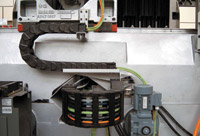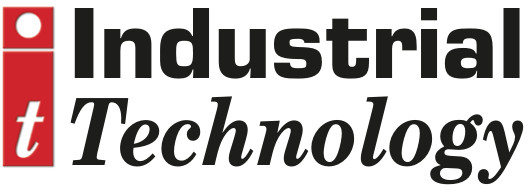
Posted to News on 23rd Apr 2012, 00:00
A critical decision: cables for dynamic applications
In today's sophisticated machines, the need for moving power and data supply is increasingly common. But, if safe and reliable operation is to be achieved, choosing the correct cable for these applications is a critical decision. Justin Leonard looks at the factors that must be considered and explains why standard cables are unsuitable.

>In a dynamic application - that is, an application where a cable is used to connect moving parts of a machine - cables may have to move backwards and forwards, in a rolling loop or even with a twisting motion. In today's high performance machines, these movements typically take place at high speed and it is common for them to be repeated thousands or even millions of times in a short timescale.
>Standard cables are totally unsuited to this type of application. They have a very simple construction where each of their copper cores is made up of a small number of relatively large conductor strands. When cables of this type are subjected to repeated bending at a small bend radius, the copper strands making up each core 'work harden', become increasingly brittle and then break.
>The same process can easily be demonstrated by bending an ordinary paper clip back and forth. Initially, it is flexible and bends easily, but after a short time it 'work hardens' and breaks. The breaking of conductor cores because of work hardening is a very common failure mode, usually leading to intermittent signals and data or shorting. There are other modes of failure when an unsuitable type of cable is used in a dynamic application.
>In multicore cables, the cores are always twisted together in layers and in standard cables this twist has a long pitch. This means that when the cable bends, the inner cores are compressed while the outer cores are stretched. After a time, this process forces the cable to take up a corkscrew shape which, in effect, shortens it, and often pulls the cores out of their terminations or connectors. The deformed cable may also form loops that get trapped in the carrier or in machine parts, damaging the outer jacket and exposing the core conductors.
>A third failure mode occurs when the cores untwist under the outer jacket of the cable, due to the forces described above. On a standard cable, this outer jacket is a simple tubular extrusion. This is beneficial when terminating the cable, because the jacket does not grip the cores tightly and is, therefore, easy to strip back. In dynamic applications, however, the jacket has the important role of stopping the cores from untwisting, and even with dummy filler cores or strings (a common trick used to pack out the inner construction on a standard cable) a simple tubular jacket is not effective in doing this. The result is that the cores untwist within the jacket, and this can be seen as bulges along the length of the cable. Ultimately, the outer jacket will burst under the strain. With shielded cables, there's yet another problem. The braiding angle of the shield is usually steep, but this means that the braid has a tendency to open up and create gaps in the shielding when the cable is flexed; this leads to a worse quality of EMC protection. Also because of the steep angle, the braid will be extended and compressed under bending leading to work harden and fracture. This leaves sharp ends that can pierce the insulation of the inner cores leading to earth faults, or cut into the outer jacket starting a split.
>So much for the shortcomings of standard cables in dynamic applications, but how do cables specifically designed for the applications - 'dynamic' cables - overcome these problems? First of all, the copper cores are more finely stranded. However, it is a common misconception that the finer the strand the better; the strand size must actually be optimised for maximum flexibility This type of construction reduces the risk of work hardening and core fractures, and can be used to give even large core high-current motor cables the flexibility needed for reliable operation in dynamic applications.
>Next, in a dynamic cable, the cores are twisted with a much shorter pitch and, in multicore cables, the cores are braided and bundled wherever possible. This means that the path of the core takes it from the outside of the cable to the inside and back again over a very short distance. Because this distance is so short, the compression and tension stresses experienced by the core, when the cable is flexed, cancel each other out to a large extent, which means that the overall level of stress on the cores is greatly reduced.
>Dynamic cables still rely on the outer jacket to prevent the cores from untwisting, but instead of a plain extruded jacket, a good dynamic cable will have a pressure-filled jacket. This fills all of the space around the cores (meaning dummy cores or strings are not needed) and ensures that they cannot untwist.
>In good quality dynamic cables where EMC shielding is required, this will be of the braided type rather than wound foil, and it will have a shallow braid angle to prevent gaps opening up as the cable flexes, which would reduce the effectiveness of the shielding. The shallow angle reduces stress on the strands, whose sizes will also have been chosen to maximise flexibility, while minimising the risk of work hardening.
>Because of their special construction, dynamic cables often feel stiffer than their standard counterparts. This shows that the myth suggesting that the cables most suitable for dynamic applications are the most flexible is not only wrong but also misleading. A rough and ready test to determine whether or not a cable is properly constructed for dynamic applications is to bend it tightly. A good dynamic cable will return immediately to its original shape when released, but other cables will tend to retain a kink.
>We have already seen why it is essential to use dynamic cables in dynamic applications if safety and reliability are to be assured, but it is also necessary to choose the right dynamic cable for the task in hand. The information needed to make this choice falls into three areas - electrical, mechanical and environmental.
>The electrical information needed is principally the number of cores required and their cross section, and whether or not shielding is needed. The cross section will depend on the current the cable is required to carry and, particularly for longer cables, the maximum permissible voltage drop. If the cables are being used for data rather than power, it will also be necessary to take into account the type of communications protocol being used.
>The dominant factor is the minimum bend radius that the cable will have to adopt, which will typically match the bend radius of the energy chain or other articulated cable support.
>The minimum bend radius for a specific cable is usually expressed as factor that is a multiple of the cable diameter. For example, a 25mm diameter cable with a dynamic radius factor of 10 can withstand bending at a minimum radius of 250mm. It is very important when working with these figures to be absolutely certain that the factor used is applicable for repeated dynamic use - the factor for static bending is likely to be much lower and, if it used in dynamic applications, early cable failure is likely to occur.
>The dynamic bend radius factor for a good dynamic cable should always be accompanied by the guaranteed minimum life of the cable, expressed in millions of cycles, when that factor is used. Igus Chainflex cables are, for example, designed for 10 million cycles at the factors quoted by the company. For most types of dynamic cable, the dynamic bend factor is typically around 10, but it is worth noting that newer cables with dynamic bend factors as low as 4 are now being introduced for some applications. Among the other mechanical considerations are the travel length, speed and acceleration. The higher these are, the more strain will be placed on the cable.
>Environmental questions that need to be answered include, for example, is the cable exposed to direct sunlight or other UV sources? Is it subject to caustic washdown or exposure to oils, solvents and dirt? What is the required operating temperature range? The answers to these questions will principally determine the type of material used for the cable outer jacket.
>The last step in getting the best from dynamic cables is ensuring that they are installed correctly. Almost always, they will require some form of support and articulated carriers, for example those in the igus energy chain range provide a versatile and convenient option. The cables must, of course, be fitted properly within the chain with particular attention given to the provision of strain relief. This is usually achieved by the use of saddle clamps, but the clamps chosen must, once again, be suitable for dynamic applications where the forces they have to withstand are many times higher than those experienced in static cable systems.
>Copper cables provide a versatile and convenient solution for providing power and data connections to moving parts of machines. Provided that genuine dynamic cables are used and that they are selected and installed correctly, solutions of this type are safe, reliable and cost effective. However, as this article has made clear, any attempt to cut corners or trim budgets by using standard cables is doomed to failure, and will without doubt lead to inconvenience and ultimately higher costs.
>The conclusion is, therefore, simple. For dynamic applications, use good quality dynamic cables from a reputable supplier that can provide dependable advice and guidance on getting the best from them.








